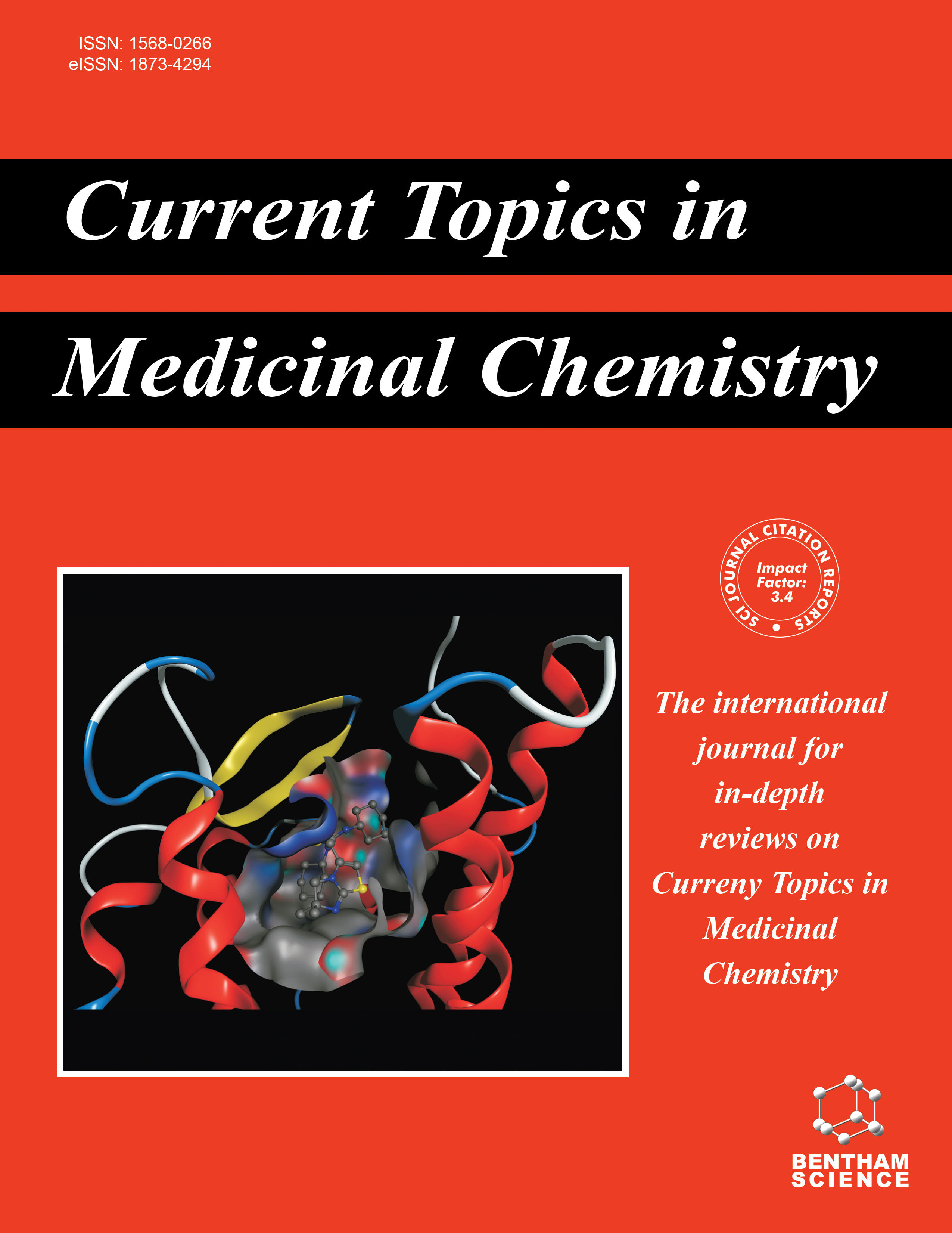- Home
- A-Z Publications
- Current Topics in Medicinal Chemistry
- Previous Issues
- Volume 16, Issue 30, 2016
Current Topics in Medicinal Chemistry - Volume 16, Issue 30, 2016
Volume 16, Issue 30, 2016
-
-
Compounds Containing Azole Scaffolds as Cyclooxygenase Inhibitors: A Review
More LessAuthors: Hanan M.A. Ragab, Adnan A. Bekhit, Sherif A.F. Rostom and Alaa El-Din A BekhitThere has been considerable interest in azole-containing compounds as promising antiinflammatory agents. Designed compounds with five-membered nitrogen-containing nuclei have demonstrated good anti-inflammatory activity, indicating their potential for the treatment of this highly irritating condition. Pyrazoles, have attracted much more attention than other azoles, however, reports on other azoles demonstrated th Read More
-
-
-
Oxazole: A Promising Building Block for the Development of Potent Antitumor Agents
More LessAuthors: Hua Zhou, Jiang-Qun Cheng, Zhi-Sen Wang, Fei-Hu Chen and Xin-Hua LiuOxazole derivatives are found to have a variety of biological activities. A large number of studies have revealed their outstanding anticancer activities. Here we review four different types of oxazole derivatives with anticancer potential reported over the last ten years. We focus our discussion on their activity, selectivity in different cancer cell lines, mechanisms of action, and their structural evolution.
-
-
-
Imidazo[1,2-a]pyridines: Promising Drug Candidate for Antitumor Therapy
More LessAuthors: Richa Goel, Vijay Luxami and Kamaldeep PaulImidazo[1,2-a]pyridine has been shown to be an important biologically active moiety. This review is a compilation of the scattered output of results of the anticancer activities of the imidazo[1,2-a]pyridine system since 2001, which have been classified as inhibition of CDK, VEGFR, PI3K, EGFR, RGGT etc. along with inhibition against different tumor cell lines. Various imidazo[1,2-a]pyridine based analogues have been used as lead Read More
-
-
-
Recent Advances in the Synthesis of 1,3-Azoles
More LessAuthors: Nadale K. Downer-Riley and Yvette A. JacksonThe 1,3-azole motif is a common and integral feature of many clinical drugs. Due to their wide-ranging applications, the development of 1,3-azoles as therapeutic agents is an ongoing focus of medicinal chemists. This review highlights the recent approaches towards the assembly of 1,3-oxazole, 1,3-thiazole and 1,3-imidazole motifs.
-
-
-
A Survey on Computational Approaches to Predicting Adverse Drug Reactions
More LessAuthors: Yun-Gu Chen, Yin-Ying Wang and Xing-Ming ZhaoAdverse drug reactions (ADRs) are the leading factors of drug attrition in drug development and post-market drug withdrawal. The identification of potential ADRs can help prevent the failure of drug discovery and improve development efficiency. Furthermore, elucidating possible ADRs for known drugs can help better understand the mechanism of drug actions and even find new indications of old drugs. Unfortunately, only Read More
-
-
-
Molecular Docking for Identification of Potential Targets for Drug Repurposing
More LessAuthors: Heng Luo, William Mattes, Donna L Mendrick and Huixiao HongUsing existing drugs for new indications (drug repurposing) is an effective method not only to reduce drug development time and costs but also to develop treatments for new disease including those that are rare. In order to discover novel indications, potential target identification is a necessary step. One widely used method to identify potential targets is through molecule docking. It requires no prior information excep Read More
-
-
-
Drug Repositioning Through Network Pharmacology
More LessAuthors: Hao Ye, Jia Wei, Kailin Tang, Ritchie Feuers and Huixiao HongLow drug productivity has been a significant problem of the pharmaceutical industry for several decades even though numerous novel technologies were introduced during this period. Currently pharmacologic dogma, “single drug, single target, single disease”, is at the root of the lack of drug productivity. From a systems biology viewpoint, network pharmacology has been proposed to complement the established guiding phar Read More
-
-
-
Methods to Profile the Macromolecular Targets of Small Compounds
More LessAuthors: Jianhua Zhu, Wei Wang and Xin ChenSmall compounds constitute most of the available medicines. However, their stereophysical and stereochemical properties are relatively simple, which typically results in promiscuity in their interactions with human proteins. Such promiscuity has caused problems in our past efforts to discover and develop new drugs, but at the same time, it also brought us new opportunities to exploit the off-target interactions between small c Read More
-
-
-
Network-based Assessment on Chemical-induced Cholestatic Liver Injury
More LessAuthors: Qian Chen, Jie Zheng, Yidan Shao, Ni Ai, Leihong Wu, Yufeng Liu, Xiaoyan Lu and Xiaohui FanThe assessment of drug toxicity, especially hepatotoxicity, is a critical task in drug development process. To assist with early detection, various in silico approaches have been demonstrated to identify drugs with high hepatotoxicity potential. In this study, based on detailed review on previous reports on drug-induced cholestatic liver injury, we developed a network-based approach to predict cholestatic potential of chemicals us Read More
-
-
-
Axin PPI Networks: New Interacting Proteins and New Targets?
More LessAuthors: Xiaomin Song, Wenwen Cai and Lin LiThe scaffold protein Axin plays important roles in multiple signaling pathways through mediating the formation of different signaling complexes. Axin is best known for its role as a negative regulator in Wnt/β-catenin pathway. Aberrant activation of the key components in Wnt/β-catenin pathway including Axin has been linked to a variety of human cancers. Drugs developed for this pathway are far from satisfying largely Read More
-
Volumes & issues
-
Volume 25 (2025)
-
Volume 24 (2024)
-
Volume 23 (2023)
-
Volume 22 (2022)
-
Volume 21 (2021)
-
Volume 20 (2020)
-
Volume 19 (2019)
-
Volume 18 (2018)
-
Volume 17 (2017)
-
Volume 16 (2016)
-
Volume 15 (2015)
-
Volume 14 (2014)
-
Volume 13 (2013)
-
Volume 12 (2012)
-
Volume 11 (2011)
-
Volume 10 (2010)
-
Volume 9 (2009)
-
Volume 8 (2008)
-
Volume 7 (2007)
-
Volume 6 (2006)
-
Volume 5 (2005)
-
Volume 4 (2004)
-
Volume 3 (2003)
-
Volume 2 (2002)
-
Volume 1 (2001)
Most Read This Month
Article
content/journals/ctmc
Journal
10
5
false
en


